How to Know if Im Not Feeding My Cat Enough
Our mission is to help save dogs' and cats' lives through our educational content. To support our efforts, this page may contain affiliate links. We earn a commission for qualifying purchases – at no cost to you.
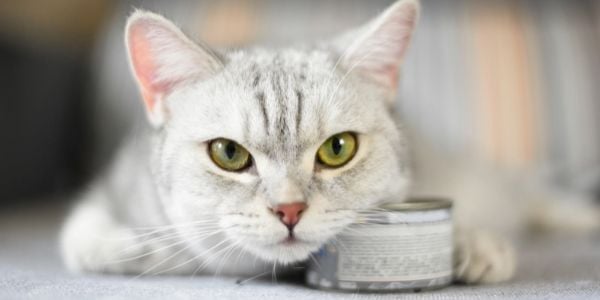
Food! Glorious food! So scrumptious and luscious! For people, food is the essence of life and can rekindle our souls.
Having meals with others is a huge social activity. It helps strengthen our relationships and allows us to become closer to others.
This same feeling translates when we are feeding our cats. We want them to eat and to enjoy eating. So when they don't want to eat or seem picky about their food, we as humans struggle with that.
So why is it cats cause us such heartache about eating? Are their palates so refined that we can't suit them? If you've ever dealt with a cat that seemingly refuses to eat, you are certainly not alone in sometimes feeling a little crazed and helpless. As for the theory about cats just being picky, it's somewhat true, but there are a lot of nuances.
How to Get Your Cat to Eat
There are several different options for trying to entice your cat to eat. You know your cat better than anyone, and based on their personality, you know the best option to start with. Additionally, you may need to combine different options. But don't try combinations until you have tried several individually first.
Location, Environment, and Bowl Type
- Determine if they are social eaters or if they prefer to dine alone. There are some cats that like to have company when they eat, and there are those that prefer the peace and quiet of eating alone.
If you have a very loving and generally sociable cat, sitting and petting them while they eat may be just what the doctor ordered to help them get back on track with eating regularly.
On the other hand, if your cat tends to prefer alone time, petting while they eat isn't going to be helpful. For these cats, place their food in a location they can eat undisturbed by people and other pets. For some cats, this may be a closet, and for others, it may be under a bed. Split their meal into a few bowls and place them in different spots, and see what location they gravitate to most. - Try placing the bowls in different locations. Something may have scared or turned off your cat where the original feeding location was, and now they dislike that spot.
We are not always around when our cats are eating. There are times when a negative event occurs in your cat's food bowl location. This can cause your cat not to feel comfortable eating in that location. You may have to try several places before you find one that suits your cat and where they want to enjoy a meal. Additionally, try placing a Feliway Diffuser (calming pheromone) in the area you place the bowl. This will naturally relax your cat. A relaxed cat is more likely to eat than a stressed cat. The Feliway pheromones mimic the pheromones their mother emitted during nursing, which has a calming effect.
- Try different types of bowls. A bowl is a bowl, is a bowl – NOPE! There are a ton of options available when you're deciding how to feed your cat. If you're concerned about whisker fatigue (explained in the section below), find a plate or a wide bowl with shallow sides so there's less chance your cat will have to squish their whiskers against the bowl.
Preferably, opt for stainless steel when it's available. It's not only durable but also easy to clean and disinfect. Similarly, ceramic and glass bowls can work, though they're easier to break. Avoid plastic bowls or containers as they can harbor bacteria when chipped or scratched, which can lead to problems like cat acne. Additionally, plastic bowls, especially when put in a microwave or warmed, can give off a smell. These smells can be a turn-off for cats.
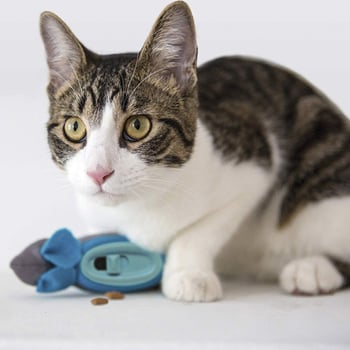
-
Don't use a bowl. If you'd like to go a step further and create intrigue regarding their food, something like this "no bowl" feeding system (featured in the photo), developed by a veterinarian, is one way to tap into that natural hunting behavior.
This particular device looks like a mouse and allows you to place a few kibbles inside. You then hide the "mouse" and let your cat do what they do best – hunt. If you feed a combination of wet and dry food, you can feed their wet food in a traditional bowl, and let them hunt for the kibble.
-
Consider other ways to feed your cat that will engage their natural instincts. Cats are not naturally prone to scarfing down a big meal for the day. As hunters, cats are more accustomed to hunting their food and eating little bits throughout the day. Periodic, small feedings — especially feedings that require your cat to move around and "hunt" their food, like from a food puzzle — can help keep your cat from becoming overweight and give an indoor cat an outlet for their pent-up energy.
Preventive Vet staff review from Chris: There was a period in which Rajah and his sister Zsa Zsa weren't getting along. What we found was that they had very few mentally stimulating activities, which led to boredom and aggression towards each other. My first purchase was the Trixie Mad Scientist Activity for its simplicity.
It has become a favorite of Rajah's (who's food motivated). He's constantly found pawing away at the activity several times a day, hoping to find some kibble. And although Zsa Zsa isn't as food motivated, she enjoys watching her brother figure out how to get the treats!
Pro Tip: Make sure you choose the appropriate dispensing top that will either allow larger kibble or treats to fall out without too much effort or to keep smaller kibble from pouring out too quickly.
For more suggestions on types of bowls and interactive feeders click here.
- Hand feed. Desperate times call for desperate measures! If other options fail, hand feeding can be helpful.
Put canned food on your finger and then gently place the food on your cat's gums. Never force-feed your cat because this can create further food aversions. Another option is to use your hands like a bowl and place dry food in them. These methods work best with cats that are social eaters.It is true desperate times call for desperate measures. I had a patient that wasn't eating but was a very social cat. So I warmed up the smelliest canned cat food I could get. I began loving on my patient by petting and scratching their head. Then I pretended while trying not to gag from the smell, to eat the food. My little friend decides to join me for a few bites. This doesn't often work, but it never hurts to try!
But if this is the only way you're able to feed your cat long-term, you'll want to have them seen by a veterinarian, as there may be medical or behavioral issues at play.
Questions? To chat with a veterinarian about stimulating your cat's appetite, Click here
Feeding Schedule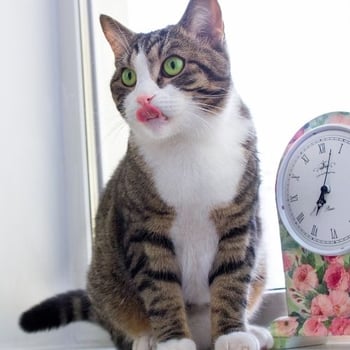
- Let them get a little bit hungry. While we often tend to leave food out all the time and let our cats graze, that can make it so they are never hungry. Picking up their food for about 12 hours will likely make them hungry enough to eat almost anything. It is best to feed them 2 to 3 meals per day for a period of time so that you know when they are fed, and they will likely be hungry and want to eat.
At the bare minimum, don't give your cat one big meal in the morning. Chances will be greater that they "scarf and barf."
- Always keep their food fresh. Cats decide what they are going to eat based on smell and taste. Just like many people don't like leftovers or stale food, neither does your cat. When food sits out, especially canned food, it loses its smell, flavor, and gets all dried out. Canned food left out too long –— between 20–45 minutes, depending on the food and how warm it is — can result in it getting dry and hard, and bugs and bacteria can start setting in, as well as other critters trying to eat it. Fresh is best!
If your cat doesn't eat within 30 minutes, lift their food up (put it in the fridge if it's canned) and put it down again at the next scheduled mealtime.
Natural Cat-Safe Enticements and Flavors
We all know cats are very discerning when it comes to their food. It must smell and taste a certain way, the texture must feel right, and some will only eat their food either wet or dry. In addition to all this, the temperature of their food sometimes matters.
To start, never suddenly switch your cat's food. This is especially important to avoid if they have been sick. Always gradually introduce new foods, especially if they smell very different.
If you know your cat prefers certain flavors and textures, try to always use those same ones. New isn't always better.
Take note of your cat's likes and dislikes while trying some of these food enhancements.
- Try some canned/wet food. The stinkier, the better — try seafood varieties. These two brands have good ingredients and are smelly.
Aloha Friends Grain-Free Wet Cat Food for All Life Stages – Seafood with Pumpkin
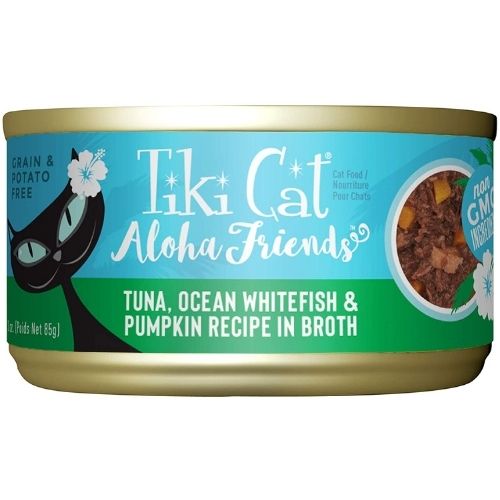
This Stella & Chewy's dry cat food is an option if you want to try a softer kibble.
Freeze-Dried Morsels for Cats – Chicken, Salmon & Chicken, Turkey

- Add a little bit of warmed, low-sodium chicken broth to their food. Avoid broths containing onions, onion powder, chives, or garlic — as these can be toxic to cats. Try mixing Native Pet's Bone Broth powder with water as a pet-safe way to add broth to their food, or sprinkle on this broth flavored powder food topper. Note: The label for this food topper product says it is for dogs, but it is safe for cats as well. As with anything new, especially if your cat has existing health issues, consult with your veterinarian prior to use.
- Add some meat baby food as a topper. Be sure that it contains no onions or garlic. These two baby food flavors are safe for cats: Chicken or Turkey.
- Add some water from a can of tuna or anchovies. Pour in on top of their regular food. Note: Anchovies can be high in sodium. Be sure to consult with your veterinarian before using if your cat is on a sodium-restricted diet.
- Add some fish oil to their food. Fish oil provides other benefits for their skin and joints as well. Nordic Naturals and Grizzly make fish oils appropriate for cats.
- Sprinkle some nutritional yeast powder onto their food. It's got a nutty, cheesy flavor that many cats go absolutely crazy for. An added bonus is that it's rich in B vitamins! (Don't confuse brewer's yeast with nutritional yeast — they're very nearly the same thing, but not exactly. Brewer's yeast often has a bitter taste, which many cats may not like.)
- Sprinkle some grated parmesan cheese on their food. The salty, cheesy flavor is often enough to pique a cat's interest and appetite.
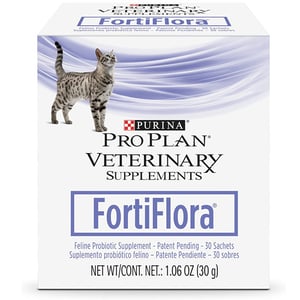
- Sprinkle some Purina FortiFlora probiotic on their food. Mix a little bit in, and then sprinkle a bit on top. Not only does FortiFlora often work great as an appetite enhancer for cats, but you're also getting the additional benefit of a proven probiotic!
- Make it smell better. Gently warm the food in the microwave or with warm water (don't make it too hot!).
Typically, warming food enhances its smell. As mentioned, smell is the first factor that cats use to determine if they will even try a food. Adding canned food, low-sodium chicken broth, or tuna to dry food and then warming it makes everything smell 10 times better and is more likely to entice your cat to eat. This is particularly helpful for cats who may be stuffy from upper respiratory infections. There are some cats, though it is only a small number, that actually prefer cold food. This is why it takes some patience and experimenting when it comes to finding your cat's preferences.
Besides warming the food, sprinkling a little goodness on top helps stimulate their appetite as well. They may only lick at the topper (grated parmesan cheese, nutritional yeast, Fortiflora, etc.), but typically within a short period of time, they will be diving into their food with excitement.
- Sprinkle some Vetriscience Perio Support on their food. For some cats, it acts as an appetite enhancer, but for every cat, it helps support clean teeth and fresh breath.
- Try catnip. Some cat owners have said that catnip has stimulated their cat's appetite. It's worth a try, as it can't harm them, and it can be a form of enrichment. Our article on catnip has a few brands that we like for cats.
If these suggestions fail, or if your cat refuses more than two meals, it's time to go to the vet for evaluation and care.
Questions? To chat with a veterinarian about why your cat isn't eating, Click here
The suggestions above are truly a short-term fix
If your cat starts eating after using one (or a combination) of these tricks, then you can possibly chalk it up to an upset stomach that will pass, a change in the weather, or something non-threatening. However, if your cat isn't eating their normal amount for a significant period of time, anything over one day (even less if they have certain pre-existing conditions, such as diabetes or obesity), then it's imperative that you take your cat to the veterinarian.
Something very serious could be causing your cat's hunger strike, and any delay can make matters significantly worse. A cat that doesn't eat could be at risk of Fatty Liver Disease (Hepatic Lipidosis).
Prescribed Appetite Stimulants
Last but not least, is prescribed appetite stimulants. These are provided by and need to be used under the guidance of your veterinarian when your cat has refused all other options, they are not well, and/or it has been more than 12 to 24 hours since they have eaten.
Based on the reason your cat isn't eating, your veterinarian may prescribe one of these commonly used appetite stimulants:
- Mirtazapine – This is an antidepressant that has several benefits for cats. This includes stimulating them to eat, gaining weight, and in some cases has helped to control nausea. It is usually a tablet (given once every 72 hours) but it is possible that it can be compounded into a transdermal gel for use on their skin.
- Cyproheptadine – This medication is an antihistamine. It stimulates a cat's appetite and can control nausea. It is often used with cats getting chemotherapy.
- Diazepam – This medication is a much less often used option since some cats can have liver issues as a result of its use. But single treatments have been found to be effective.
- Steroids – They have been found to stimulate a cat's appetites. This benefit is usually noted when other issues are being treated using them.
- B12 injections – In some cases, except for chronic gastrointestinal, these injections have been found to stimulate a cat's appetite.
Veterinary Evaluation
Proper nutrition from a well-balanced diet is important. Each nutrient in your cat's diet has an essential purpose. Being sure that your cat eats properly helps ensure a healthy life, as well as good quality of life. If your cat's appetite cannot be stimulated with the above suggestions, it is important to seek veterinary care. The sooner the issues that are causing your cat not to eat are addressed, the sooner your cat can get back to a happy life.
Truth is, typically, there will be a medical reason for a cat not eating. And, as you can see from the list below, some of those medical reasons can be quite serious.
Reasons Why Your Cat Won't Eat
Let's start with an important question. Is your cat ACTUALLY hungry? First, we must remember, cats are not very big! Additionally, the type of food you are feeding them may be very energy-dense, and depending on their activity level, it could more than satisfy their energy requirements.
We have a preconceived notion of how much we think our cats should eat based on how much we eat. Oftentimes, I would have owners come to me saying their cat isn't eating enough. Based on their cat's body condition and the numbers on the scale, I knew that wasn't the case.
A Good Rule of Thumb
If you notice your cat is:
1) eating each day (many prefer to eat when no one is around)
2) they are not losing weight
3) they appear to be happy and acting normally
Then your cat is most likely just fine!Usually cats will let you know if they're hungry, as our fun "Feed You Now" video demonstrates.
It's important to know why your cat is not eating. Is it simply because they are full, or are they being difficult or truly picky? A cat might stop eating for any number of reasons, varying from medical to non-medical.
Some medical reasons can include:
- Dental/tooth pain: broken or fractured tooth, abscessed tooth root, oral tumor, tooth resorption
- Pancreatitis (inflamed pancreas)
- Urinary obstruction
- Digestive obstruction
- Constipation
- Upper respiratory infection – also known as a "kitty cold" – if they can't smell, they likely not eat
- Kidney disease
- Liver disease
- Inflammatory Bowel Disease (IBD)
- Inflammation of the esophagus (esophagitis). This can occur due to acid reflux, ingestion of a chemical irritant, continuous vomiting, hiatal hernia, etc.
- Parasites
- Cancer
- Stress or a change within your home
Catching these medical issues early often results in a better outcome, as well as easier, less expensive treatment. And this is especially the case in cats that are a bit more "plump" than they should be, as fat cats that stop getting enough calories are at higher risk of developing a serious form of liver dysfunction (hepatic lipidosis) as a result of their decreased calorie intake.
Questions? To chat with a veterinarian about why your cat isn't eating, Click here
What is Whisker Fatigue and is it Real?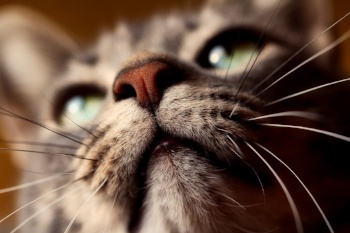
You may have heard — either from your veterinarian, news reports, or pet product manufacturers — about something called "whisker fatigue."
There's actually a lot we still don't fully understand about cat's whiskers (see the video below or read more if you feel like getting nerdy about "vibrissae").
While the thought of 'tired whiskers' sounds kinda silly, it is something that maybe you should put a little thought into if you have a feline that tends to be very sensitive. Why? Because it is a problem that can potentially make your cat act completely different.
Some of the issues it can cause are poor appetite, mood changes, and changes in behavior. All of these things cause additional stress to your cat.
Generally, people think of whiskers as a physical trait of cats. We often relate to it as we do facial hair or beards. But they are so much more complex than a beard!
Whiskers, or "vibrissae," are specialized touch organs that help mammals in a number of ways. Cats, for example, have 100–200 nerve cells per whisker. As the whisker comes into contact with an object, the cat translates that sensory information to help build a description of their environment, like whether a space is too narrow for them to safely pass through.
Simply put, whisker fatigue occurs when these highly sensitive vibrissae are repeatedly over-stimulated. This can happen with repeated hits to the sides of a food or water bowl, causing discomfort, desensitization, and stress.
Over enough time, this can cause the following:
- Refusal to use their regular water and food bowls
- They may pace and meow in front of their feeding station
- They may attempt to spill or dig out their food from their bowls
- Aggressive behavior has been noted with some cats when they have been given food or treats outside of their feeding bowls1
The process of combating whisker fatigue is simple. Don't use deep and narrow bowls. Rather, use wide and shallow ones so that the sides do not contact your cat's whiskers. If you can't find one of these bowls, you can use a plate or saucer.
Whiskers are extremely important to our feline companions. But is whisker fatigue a new fact, or is it far-reaching fiction? Many feel, as more research is done on cat behavior, that we are creating stress for our cats by making them participate in the lifestyle, we have created for them. Typically, a cat's nature is to be outdoors and solitary. We have brought them into a pack environment indoors. Therefore, as responsible pet owners, we need to lessen environmental stresses on our cats as well as provide them with enrichment.
The science is still out on whisker fatigue. More to the point, there currently is no science on whisker fatigue, as there are currently no studies to say definitively whether whisker fatigue is real. But that hasn't stopped a significant group from arguing that it's something to watch out for.
One person told the New York Times about whisker fatigue, "I think it's just one of those things where people say, 'Oh, cats are just finicky eaters,' and everyone thinks it's a joke. After reading some articles about this, I was like, maybe this isn't a joke after all."
There are even a number of feeding products aimed at reducing whisker fatigue in cats, such as shallower bowls with edges that don't touch a cat's whiskers and with a rounded interior so food doesn't become trapped in the corners.
Of course, there are also plenty of skeptics. Chris Sweeney wrote in Boston Magazine that there is little evidence from veterinary associations or veterinary medical schools to support whisker fatigue as a "thing." Furthermore, the World Small Animal Veterinary Association (WSAVA) told Preventive Vet in 2017 that it "has no information specific to this condition, whether through our scientific working groups or as part of our continuing education offerings."
But here's the rub on whisker fatigue: The lack of current evidence doesn't necessarily mean that it doesn't — or couldn't — exist. Whisker fatigue makes sense in theory, as whiskers are very highly sensitive structures/organs that could become desensitized or "fatigued" from repeated stimulation (such desensitization is a known phenomenon in other nerve fibers). Further study will likely verify some of the theory, eventually. In other words, whisker fatigue is a solid hypothesis based on interesting observations that would benefit from scientific study.
Does that mean you need to go out and buy a $60 specialized whisker fatigue bowl? Absolutely not. In fact, a low-sided bowl — or even a plate — will work just fine.
Have any stories about your cat's finicky eating habits? Any questions we haven't touched on here? Let us know in the comments!
Please share a bit of information about your cat's food and litter box habits

The information you share will help many other cats.
It's anonymous and will take 1–2 minutes.
Thank you!
Source: https://www.preventivevet.com/cats/cat-wont-eat-how-to-stimulate-your-cats-appetite
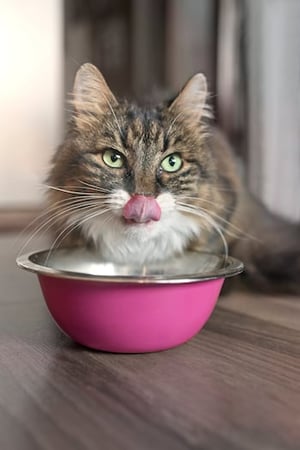
0 Response to "How to Know if Im Not Feeding My Cat Enough"
Post a Comment